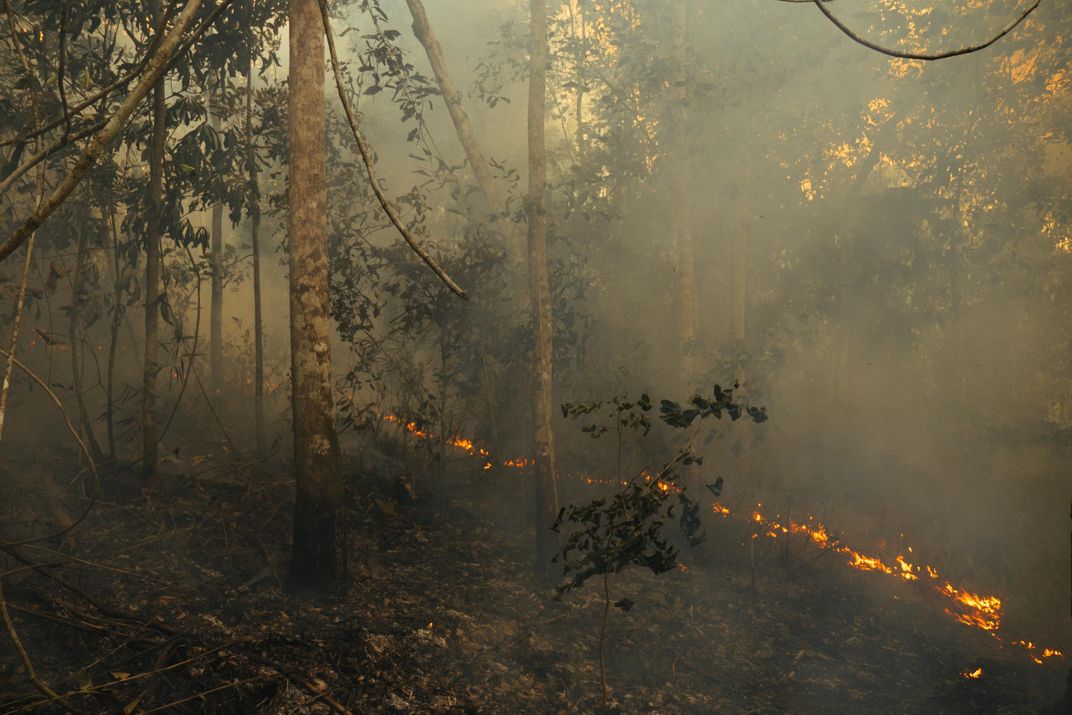Unfortunately, Reducing Deforestation Isn’t Enough To Protect Amazon Biodiversity
Logging, wildfires and other human disturbances lead to species die-offs
/https://tf-cmsv2-smithsonianmag-media.s3.amazonaws.com/filer/d8/9b/d89bdc9a-d751-4241-87aa-dd4d4c71019f/42-33399094.jpg)
Forest loss in the Amazon continues, but over the last decade, it has largely been slowing down in Brazil. That may seem like a win for the region’s unique biodiversity, but simply halting deforestation won’t be enough to stem the loss in species, a new study in Nature contends. That’s because human disturbance—such as wildfires and selective logging, which can continue even when clearcutting stops—have an outsized impact on biodiversity loss, the study finds.
Brazil has been able to slow its once-rampant deforestation with a Forest Code that says landowners must preserve 80 percent of their land as forest cover. But those forested areas still face threats from humans; roads and selective logging are allowed in them, and wildfires can easily spread from the agricultural areas where they are deliberately started.
Previous studies have looked at the effects of such disturbances on biodiversity singly, but “those things don’t happen in isolation,” notes Toby Gardner, a sustainability scientist with the Stockholm Environment Institute and the International Institute for Sustainability in Brazil. Many of these disturbances feed off one another. A logged forest is more likely to burn, for example, and if land burns once, it’s more likely to burn again. Without studying all of these disturbances together, their full impacts can’t be known.
So Gardner and an international group of researchers created a network to assess biodiversity across 36 landscapes in the Brazilian state of Pará, which is home to about a quarter of the Amazon. The scientists looked at three groups of species—trees, birds and dung beetles (the last group is easy to survey, Garner notes, in addition to being “excellent indicators of environmental change”)—and compared diversity in deforested areas with areas that had been disturbed.
Losing 20 percent of forest cover in an area resulted in a 39 to 54 percent loss of conservation value, a measure of species richness, the scientists calculated. That is two to nearly three times what might be expected from deforestation alone, and the scientists determined that human disturbances cause the additional loss. Worse, rare species that may be found nowhere else in the world are often the ones that are most affected by these disturbances, the team found.
Extrapolating from the study areas to the entire state, the researchers calculated that the biodiversity loss from human disturbance was equivalent to clearcutting as much as 139,000 square kilometers of pristine forest, an area of land the size of North Carolina.

Limiting deforestation is an important step for preserving the biodiversity of tropical forests, Gardner says, but these results show that it’s not enough. “The forests that remain, they’re a shadow—functionally, biologically, ecologically—of the forests that once stood there,” he says. In Pará, he notes, there are very few, if any, forests left that have not been impacted in some way by either deforestation or human disturbance.
David Edwards, a conservation scientist at the University of Sheffield who wrote an accompanying commentary in Nature, agrees with Gardner’s group. “Just focusing on stopping deforestation is not enough. We must also focus on preservation of forest quality,” he says.
There is no easy solution, though. Halting the slow decline of biodiversity would require an integrated approach that includes better land use planning and more enforcement of existing laws against illegal logging, hunting and use of fire, Edwards says—a process that would be expensive and time-consuming. Without that, species are at risk of disappearing, especially those that are found in only small areas of the Amazon.
“I’m sure [the new findings] won’t be surprising to conservation biologists and ecologists because forest cover is not a very good measure of all the complex processes happening inside the forest,” says Tremaine Gregory, a primatologist with the Smithsonian Conservation Biology Institute who has been studying how animals respond to hydrocarbon exploration in the Peruvian Amazon. “When you work in the tropical forest…you can see what an interconnected web it is.”
Gregory and her colleagues are trying to find solutions to minimize the impact of human presence in the Amazon, such as making sure that monkeys and other arboreal animals have paths through the trees that let them cross natural gas lines. The new study, she says, shows that such research has value.
“We are continuing to have a major distorted influence on our ecosystem and our planet,” she says. But if human activities have to happen in certain areas, “it should be done in the least impactful way possible. And we can only know what those low-impact methods are if we carry out robust scientific studies to understand them.”
The impacts seen in the Brazilian Amazon may be indicative of problems going on elsewhere in the world, Gardner says. The types of disturbance may vary from place to place, “but the problem is general.” And the most heavily disturbed forests, such as the ones found in the eastern United States, he says, are “all shadows of what they once were.”
/https://tf-cmsv2-smithsonianmag-media.s3.amazonaws.com/accounts/headshot/Sarah-Zielinski-240.jpg)
/https://tf-cmsv2-smithsonianmag-media.s3.amazonaws.com/accounts/headshot/Sarah-Zielinski-240.jpg)